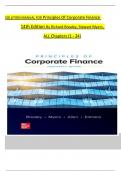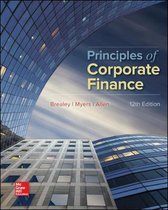SOLUTION MANUAL FOR Principles Of Corporate Finance
14th Edition By Richard Brealey, Stewart Myers,
ALL Chapters (1 - 34)
, TABLE OF CONTENTS
Chapter 1: Introduction to Corporate Finance
Chapter 2: How to Calculate Present Values
Chapter 3: Valuing Bonds
Chapter 4: Valuing Stocks
Chapter 5: Net Present Value and Other Investment Criteria
Chapter 6: Making Investment Decisions with the Net Present Value Rule
Chapter 7: Introduction to Risk, Diversification, and Portfolio Selection
Chapter 8: The Capital Asset Pricing Model
Chapter 9: Risk and the Cost of Capital
Chapter 10: Project Analysis
Chapter 11: How to Ensure That Projects Truly Have PositiveNPVs
Chapter 12: Efficient Markets and Behavioral Finance
Chapter 13: An Overview of Corporate Financing
Chapter 14: How Corporations Issue Securities
Chapter 15: Payout Policy
Chapter 16: Does Debt Policy Matter?
Chapter 17: How Much Should a Corporation Borrow?
Chapter 18: Financing and Valuation
Chapter 19: Agency Problems and Corporate Governance
Chapter 20: Stakeholder Capitalism and Responsible Business
Chapter 21: Understanding Options
Chapter 22: Valuing Options
Chapter 23: Real Options
Chapter 24: Credit Risk and the Value of Corporate Debt
Chapter 25: The Many Different Kinds of Debt
Chapter 26: Leasing
Chapter 27: Managing Risk
Chapter 28: International Financial Management
Chapter 29: Financial Analysis
Chapter 30: Financial Planning
Chapter 31: Working Capital Management
,Chapter 32: Mergers
Chapter 33: Corporate Restructuring
Chapter 34: Conclusion: What We Do and Do Not Know about Finance
CHAPTER 1
Introduction to Corporate Finance
The values shown in the solutions may be rounded for display purposes. However, the answers werederived using
a spreadsheet without any intermediate rounding.
Answers to Problem Sets
1. a. real
b. executive airplanes
c. brand names
d. financial
e. bonds
*f. investment or capital expenditure
*g. capital budgeting or investment
h. financing
*Note that f and g are interchangeable in the question.
Est time: 01-05
2. A trademark, a factory, undeveloped land, and your work force (c, d, e, and g) are all real assets. Real
assets are identifiable as items with intrinsic value. The others in the list are financial assets, that is, these
assets derive value because of a contractual claim.
Est time: 01-05
3. a. Financial assets, such as stocks or bank loans, are claims held by investors. Corporations sell
, financial assets to raise the cash to invest in real assets such as plantand equipment. Some real
assets are intangible.
b. Capital expenditure means investment in real assets. Financing means raising the cashfor this
investment.
c. The shares of public corporations are traded on stock exchanges and can be purchasedby a
wide range of investors. The shares of closely held corporations are not publicly traded and are
held by a small group of private investors.
d. Unlimited liability: Investors are responsible for all the firm‘s debts. A sole proprietor has
unlimited liability. Investors in corporations have limited liability. They can lose their
investment, but no more.
Est time: 01-05
,4. Items c and d apply to corporations. Because corporations have perpetual life, ownership can be
transferred without affecting operations, and managers can be fired with no effect on ownership. Other
forms of business may have unlimited liability and limited life.
Est time: 01-05
5. Separation of ownership facilitates the key attributes of a corporation, including limited liability for
investors, transferability of ownership, a separate legal personality of the corporation, and delegated
centralized management. These four attributes provide substantial benefit for investors, including the
ability to diversify their investment among many uncorrelated returns—a very valuable tool explored in
later chapters. Also, these attributes allow investors to quickly exit,enter, or short sell an investment,
thereby generating an active liquid market for corporations.
However, these positive aspects also introduce substantial negative externalities as well. The separation
of ownership from management typically leads to agency problems, where managersprefer to consume
private perks or make other decisions for their private benefit—rather than maximize shareholder
wealth. Shareholders tend to exercise less oversight of each individual investment as their diversification
increases. Finally, the corporation‘s separate legal personalitymakes it difficult to enforce accountability if
they externalize costs onto society.
Est time: 01-05
6. Shareholders will only vote to maximize shareholder wealth. Shareholders can modify their pattern
of consumption through borrowing and lending, match risk preferences, and hopefullybalance their
own checkbooks (or hire a qualified professional to help them with these tasks).
Est time: 01-05
7. If the investment increases the firm‘s wealth, it increases the firm‘s share value. Ms. Espinozacould
then sell some or all these more valuable shares to provide for her retirement income.
Est time: 01-05
8. a. Assuming that the encabulator market is risky, an 8% expected return onthe
F&H encabulator investments may be inferior to a 4% return on U.S.
government securities, depending on the relative risk between the two assets.
b. Unless the financial assets are as safe as U.S. government securities, their cost of capitalwould be
higher. The CFO could consider expected returns on assets with similar risk.
Est time: 06-10
9. Managers would act in shareholders‘ interests because they have a legal duty to act in their interests.
Managers may also receive compensation— bonuses, stock, and option payouts with value tied (roughly)
to firm performance. Managers may fear personal reputational damage from not acting in shareholders‘
interests. And managers can be fired by the board of directors (electedby shareholders). If managers still
fail to act in shareholders‘ interests, shareholders may sell their shares, lowering the stock price and
potentially creating the possibility of a takeover, which can again lead to changes in the board of directors
and senior management.
Est time: 01-05
,10. Managers that are insulated from takeovers may be more prone to agency problems and therefore more
likely to act in their own interests rather than in shareholders‘. If a firm instituted anew takeover
defense, we might expect to see the value of its shares decline as agency problems increase and less
shareholder value maximization occurs. The counterargument is thatdefensive measures allow managers
to negotiate for a higher purchase price in the face of a takeover bid—to the benefit of shareholder
value.
Est time: 01-05
Appendix Questions:
1.Both would still invest in their friend‘s business. A invests and receives $121,000 for his investment
at the end of the year—which is greater than the $120,000 that would be receivedfrom lending at
20% ($100,000 × 1.20 = $120,000). G also invests, but borrows against the
$121,000 payment, and thus receives $100,833 ($121,.20) today.
Est time: 01-05
2. a. He could consume up to $200,000 now (forgoing all future consumption) or up to $216,000 next year
($200,000 × 1.08, forgoing all consumption this year). He should invest all of his wealthto earn $216,000
next year. To choose the same consumption (C) in both years, C = ($200,000
– C) × 1.08 = $103,846.
Dollars Next Year
220,000
216,000
203,704
200,000
Dollars Now
b. He should invest all of his wealth to earn $220,000 ($200,000 × 1.10) next year. If he consumes all this
year, he can now have a total of $203,703.70 ($200,000 × 1.10/1.08) this yearor $220,000 next year. If
he consumes C this year, the amount available for next year‘s consumption is ($203,703.70 – C) × 1.08.
To get equal consumption in both years, set the amount consumed today equal to the amount next
year:
C = ($203,703.70 – C) × 1.08
C = $105,769.20
Est time: 06-10
, CHAPTER 2
How to Calculate Present Values
The values shown in the solutions may be rounded for display purposes. However, the answers werederived using
a spreadsheet without any intermediate rounding.
Answers to Problem Sets
1. a. False. The opportunity cost of capital varies with the risks associated with each individualproject
or investment. The cost of borrowing is unrelated to these risks.
b. True. The opportunity cost of capital depends on the risks associated with each project andits cash
flows.
c. True. The opportunity cost of capital is dependent on the rates of returns shareholders canearn
on the own by investing in projects with similar risks
d. False. Bank accounts, within FDIC limits, are considered to be risk-free. Unless an investmentis also
risk-free, its opportunity cost of capital must be adjusted upward to account for the associated
risks.
Est time: 01-05
2. a. In the first year, you will earn $1,000 × 0.04 = $40.00
b. In the second year, you will earn $1,040 × 0.04 = $41.60
c. By the end of the ninth year, you will accrue a principle of $1,040 × (1.049) = $1,423.31.
Therefore, in the Tenth year, you will earn $1,423.31 × 0.04 = $56.93
Est time: 01-05
3.
Transistors Transistors (1 r)t
2019 1972
32, 000, 000, 000 2, 250 (1 r)48
r 40.94% 59.00% rPredicted
Est time: 01-05
4. The ―Rule of 72‖ is a rule of thumb that says with discrete compounding the time it takes for an
investment to double in value is roughly 72/interest rate (in percent).
Therefore, without a calculator, the Rule of 72 estimate is:
Time to double = 72 / r
Time to double =
,Time to double = 18 years, so less than 25 years.
, If you did have a calculator handy, this estimate is verified as followed:
Ct = PV × (1 + r)t
t = ln2 / ln1.04
t = 17.67 years
Est time: 01-05
5. a. Using the inflation adjusted 1958 price of $1,060, the real return per annum is:
$450,300,000 = $1,060 × (1 + r)(2017-1958)
r = [$450,300,000/$1,060](1/59 ) – 1 = 0.2456 or 24.56% per annum
b. Using the inflation adjusted 1519 price of $575,000, the real return per annum is:
$450,300,000 = $575,000 × (1 + r)(2017-1519)
r = [$450,300,000/$575,000](1/498 ) – 1 = 0.0135 or 1.35% per annum
Est time: 01-05
6. Ct = PV × (1 + r)t C8
= $100 × 1.158C8 =
$305.90
Est time: 01-05
7. a. Ct = PV × (1 + r)t
C10 = $100 × 1.0610
C10 = $179.08
b. Ct = PV × (1 + r)t C20
= $100 × 1.0620C20 =
$320.71
c. Ct = PV × (1 + r)t C10
= $100 × 1.0410C10 =
$148.02
d. Ct = PV × (1 + r)t C20
= $100 × 1.0420C20 =
$219.11
Est time: 01-05
8. a. PV = Ct × DFt DFt =
$125 / $139DFt =
.8993
, b. Ct = PV × (1 + r)t
$139 = $125 × (1+r)5
r = [$139/$125](1/5) – 1 = 0.0215 or 2.15%
Est time: 01-05
9. PV = Ct / (1 + r)t PV
= $.099PV =
$172.20
Est time: 01-05
10. PV = C1 / (1 + r)1 + C2 / (1 + r)2 + C3 / (1 + r)3 PV =
$.15 + $.152 + $.153PV =
$1,003.28
NPV = PV – investment
NPV = $1,003.28 – 1,200
NPV = –$196.72
Est time: 01-05
11. The basic present value formula is: PV = C / (1 + r)t
a. PV = $.0110
PV = $90.53
b. PV = $.1310
PV = $29.46
c. PV = $.2515
PV = $3.52
d. PV = C1 / (1 + r) + C2 / (1 + r)2 + C3 / (1 + r)3 PV =
$.12 + $.122 + $.123PV =
$89.29 + $79.72 + $71.18
PV = $240.18
Est time: 01-05
10
(1.12)
Ct
12. NPV
t
t 0
NPV = –$380,000 + $50,.12 + $57,.122 + $75,.123 + $80,.124 +
$85,.125 + $92,.126 + $92,.127 + $80,.128 + $68,.129
+ $50,.1210
NPV = $23,696.15
Est time: 01-05





